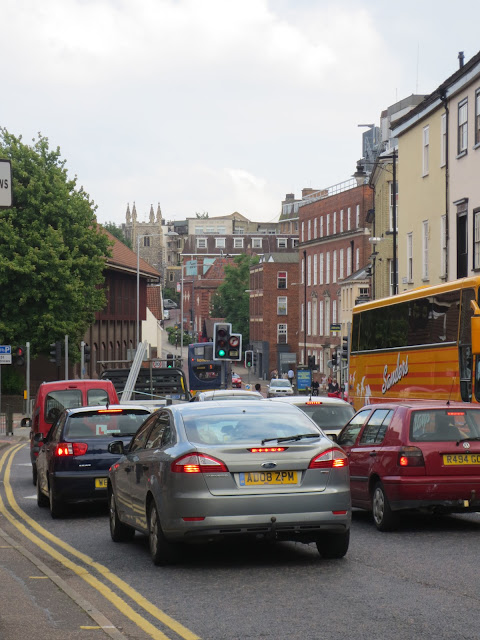Upon leaving the faux 14th century cathedral, disappointingly new, the clouds begin to set in.
My journey through Norwich, so far, has taken me to several churches and to a castle. I trek back the way I came but then turn east, cross a busy highway via footbridge and head back across the face of downtown Norwich. I head through a shopping district (these appear to be spattered all over the place, and I would later hear that it's one of the city's more endearing characteristics), my faithful copy of Finnegans Wake clutched under my arm, and my camera tucked cautiously into my jacket pocket.
Walking through English cities alone, whether Norwich or Cambridge or London, is a somber affair. You ogle street shops reproachfully, their merchandise less enticing as mocking for a student visiting on less than thirty quid; you wonder whether locals can tell you're not from here and try to think of where they might guess (Edinburgh? Essex? Norfolk? all wrong!); you hold your possessions close to your body, feather the camera in your pocket compulsively, doing your best to look comfortable. Temporary English transplant wanders stupidly, looks awkward. Norwich is a beautiful city, but it is still a long way from home.
 |
| This doorway originates from Viking Norwich. |
 |
| Another bridge over the river Wensum. |
 |
| Pointed toward the sky, Norwich Cathedral towers over the rest of the city scape. |
 |
| The gate to Norwich Cathedral...and a Adnam's truck. |
The Norwich Cathedral is a monument to the middle ages. Its construction was begun in 1069 in the wake of William the Conqueror's Normanization of Anglo-Saxon England. The cathedral was finished in 1145, two Anglo-Saxon churches and a settlement having made way (unwillingly) for its erection.
As I step into the cathedral via the Hostry, a visitor entrance used to preserve the massive twelfth century main doors, I am greeted by a woman who hands me a pamphlet, then directs me to where I can donate money. I manage to slip away from her as she accosts another group and enter the nave, where the beautiful Norman architecture can be seen in full (below).
 |
| Time, date stamp. |
I amble around the Ambulatory to Jesus Chapel, St. Saviour'sChapel and St Luke's Chapel and snap a few photos.
This display (below) is Norwich's finest collection of late medieval, Renaissance, and nineteenth century artifacts. The location is called the "Reliquary Chapel" where saints' relics would be kept so people could come to make offerings and pray on them. Relics were essentially body parts or clothing from a saint (bones, pieces of hair, scarves, etc.) although very few of them were actually parts or related to those saints. Usually, churches laid claim to parishes and fiefs on the authority of these relics (also regal and papal grants contributed, though these often came about due to the locations of the relics). During the Viking Age, when Norwich and its surrounding countryside were besieged by foreign looters, relics would have to be either transposed (called a "translation of relics" from one place to another) or risk them being destroyed. The relics that would have been held in Norwich Cathedral during the early Norman period would not have had this problem, luckily. The tradition of relics has been dissolved many years ago.
 |
| Norwich Cathedral cloister. It was under construction at one side, but I was able to go up into it and walk around. In the center is a maze, laid out in brick on the grass. |
 I decide to do some exploring and go over the Wensum via the Foundry Bridge and turn north, walking riverside until I come to Bishopgate, where I cross back over the Wensum and enter an unnamed park.
I decide to do some exploring and go over the Wensum via the Foundry Bridge and turn north, walking riverside until I come to Bishopgate, where I cross back over the Wensum and enter an unnamed park.There I find Cow Tower, which was constructed in the final years of the 14th century. The tower is located on the bank of the Wensum, and was taken and damaged seriously by Robert Kett in a rebellion during the middle sixteenth century. Kett's rebellion against Edward VI ended at the battle of Dussindale, when he was captured, put into the Tower of London, and then executed by hanging in 1549.
I love this tower. I'm not sure what it is, but the architecture reminds me of something I (dorkily) have seen in video games: that quintessential late Middle Ages fortification.
Next to Cow Tower is this odd fortification for birds...
I stop at the Red Lion for a pint and sit and relax for a while and read.
I start heading back to the train station, but head into a cheap restaurant and grab a bite to eat. Even though the day is not entirely over (it's about five thirty when I get some food), I am exhausted from walking all day. I have a pretty tasty hamburger and then head back to the station, back to Cambridge.

























No comments:
Post a Comment